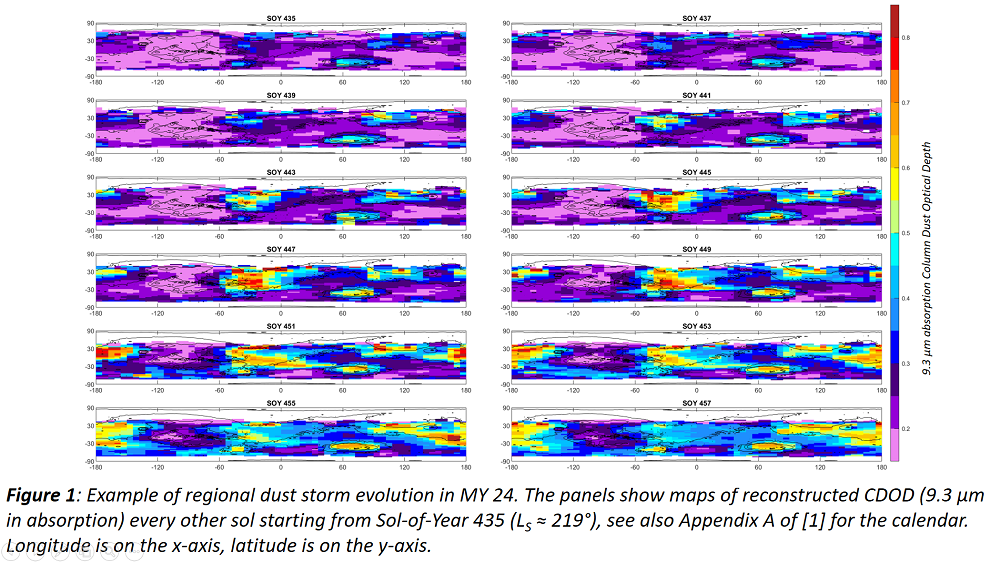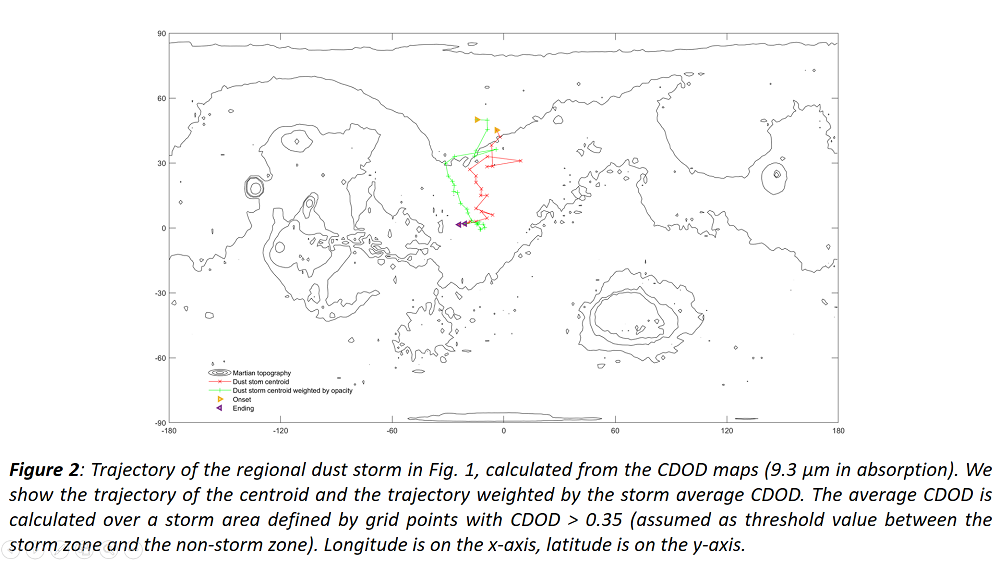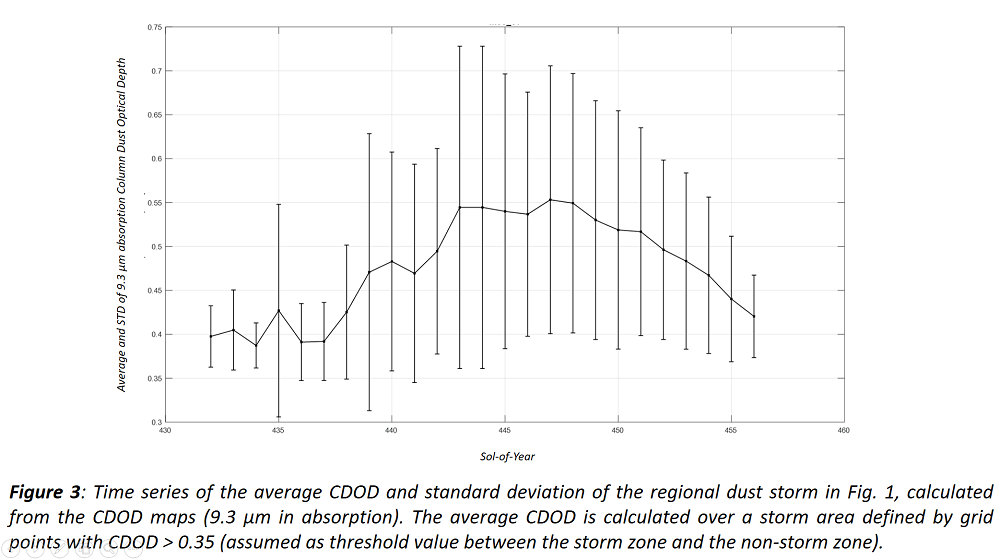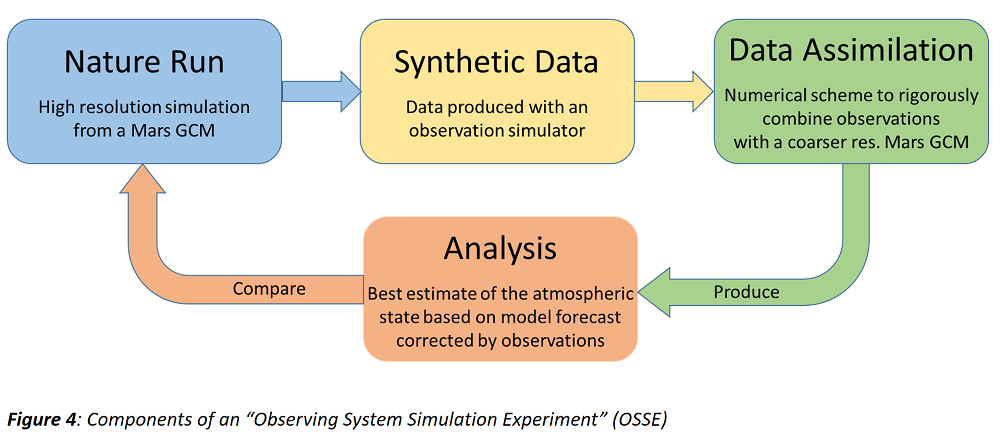From Reconstructing to Monitoring Martian Dust Storms
- 1Laboratoire de Météorologie Dynamique, IPSL, CNRS, Sorbonne Université, Paris, France
- 2Paneureka, Le Bourget-du-Lac, France (lmontabone@paneureka.org)
- 3Department of Physics and National Space Science and Technology Center, United Arab Emirates University, Al Ain, UAE
We have accumulated almost uninterrupted observations of dust from satellites in orbit around Mars for more than 20 years to date. Such a long-term and multi-instrument record can be used to identify dust events, including large-scale dust storms, occurring in the last 13 Martian Years (MY). Using observations from three American instruments operating in the thermal infrared, namely the Thermal Emission Spectrometer (TES, aboard Mars Global Surveyor), the Thermal Emission Imaging System (THEMIS, aboard Mars Odyssey), and the Mars Climate Sounder (MCS, aboard Mars Reconnaissance Orbiter), we have been able to reconstruct diurnal maps of column dust optical depth (CDOD) from mid-summer in MY 24 to the end of MY 35 [1, 2]. These maps are used as input “dust scenario” in the Mars Climate Database (MCD, [3]), among other practical applications. They are publicly available in NetCDF format on a dedicated webpage of the MCD website [4].
The quality of these diurnal CDOD maps also allows the identification of large-scale dust storms (so-called “regional” and “global” storms) and the reconstruction of their main characteristics in space and time, such as the trajectory, area, and average optical depth (see Figures 1 to 3). This work is aimed at 1) building a long-term record of key dust storm characteristics based on satellite observations in the thermal infrared, 2) comparing this record to data derived from satellite observations at visible wavelengths, and 3) producing reliable statistics for Mars science and exploration, leading to statistical large-scale dust storm prediction.



Despite the successful application of our methodology to reconstruct diurnal CDOD maps and identify large-scale dust storms, we are strongly limited by the low-altitude, quasi-polar, Sun-synchronous orbits of the Martian satellites used so far, which produce asynchronous and discontinuous observations at fixed local times. The use of observations from the European Planetary Fourier Spectrometer (PFS, aboard Mars Express) and the Russian thermal infrared channel of the Atmospheric Chemical Suite (ACS/TIRVIM aboard Trace Gas Orbiter) could help to span different local times with respect to those observed by TES, THEMIS and MCS. Nonetheless, observations from Mars Express (MEx) and Trace Gas Orbiter (TGO) are still discontinuous and asynchronous, with a sparser spatial coverage (PFS) or shorter time coverage (ACS/TIRVIM) than MCS.
A recent novelty is represented by the Emirates Mars Mission “Hope” satellite, which has been put in a high-altitude, low-inclination orbit at the beginning of 2021. Observations from the instruments aboard this spacecraft (we are particularly interested in the Emirates Mars Infrared Spectrometer -EMIRS) cover larger areas on the planet and multiple local times simultaneously, thus having the potential to improve the quality of our reconstructed CDOD maps and dust storm characteristics. However, the dynamics of Martian dust storms is characterized by rapid temporal variability (sub-hourly), and multi-scale spatial extension (local, regional, planetary), while observations by any single spacecraft are more or less discontinuous and asynchronous, hence limiting the possibility to reconstruct the correct evolution of the storms in space and time.
In order to overcome this limitation, a constellation of orbiting spacecraft including at least three areostationary or areosynchronous satellites (having Mars-synchronous, circular, equatorial or slightly inclined orbits), possibly in addition to at least one low-altitude polar orbiter, has been previously proposed [5, 6, and references therein]. Such a constellation could provide continuous and simultaneous observations of almost the entire planet, thus allowing monitoring of the complete evolution of dust storms (at least large-scale ones, depending on the resolution of the on-board instruments), and of the Martian weather in general.
While waiting for the first available opportunity to launch a weather-monitoring satellite constellation to Mars, we can provide a quantitative assessment of the improvement in weather characterization (dust storms in particular) due to the introduction of specific new observations, using “Observing System Simulation Experiments” (OSSEs). This framework has been used for more than 30 years as a tool to evaluate the benefits of future instruments for the Earth, so it is timing to use it also to simulate the impact of atmospheric observations that do not yet exist for Mars [7].

An OSSE framework has three components, as shown in Fig. 4. The nature run is a simulation by a state-of-the-art Global Climate Model (GCM) at high resolution, which is meant to represent the real state of the atmosphere. Synthetic data are produced by simulating the observations to be tested in the OSSE, using an observation simulator that extracts information from the nature run. In other words, the simulator produces the observations that would be taken by a specified instrument when probing the virtual atmosphere provided by the GCM simulation. The data assimilation scheme is a numerical annex to an atmospheric model (usually a GCM) that combines observations with the model in a rigorous, mathematical way. The purpose is to produce an “analysis” of the atmospheric state, i.e. the best estimate of this state using a model forecast corrected by observations, taking into account both model and observation errors. The analysis is then compared to the nature run in order to quantify the impact of new observations in the model characterisation of the temperature and wind fields, including waves, and of the aerosol fields, including the evolution of dust storms.
In this work, we have started using the state-of-the-art Mars “Planetary Climate Model” with the Laboratoire de Météorologie Dynamique longitude-latitude grid dynamical core (Mars PCM-LMDZ, [8]), coupled with the “Local Ensemble Transform Kalman Filter” (LETKF) assimilation scheme [9], in order to optimize the configuration of a weather-monitoring constellation based on different combinations of polar orbiters and areostationary satellites with on-board thermal infrared radiometers.
REFERENCES
[1] Montabone et al. (2015) Icarus 251, pp. 65-95, doi: 10.1016/j.icarus.2014.12.034
[2] Montabone et al (2020) J. Geophys. Res. - Planets, doi: 10.1029/2019JE006111
[3] Millour et al. (2022) 7th MAMO Workshop, Paris, http://www-mars.lmd.jussieu.fr/paris2022/abstracts/oral_Millour_Ehouarn.pdf
[4] http://www-mars.lmd.jussieu.fr/mars/dust_climatology/
[5] Montabone et al. (2021) EPSC 2021, 625, https://doi.org/10.5194/epsc2021-625
[6] Montabone et al. (2022) 7th MAMO Workshop, Paris, http://www-mars.lmd.jussieu.fr/paris2022/abstracts/oral_Montabone_Luca.pdf
[7] Reale, O. et al. (2021) BAAS, 53(4), https://doi.org/10.3847/25c2cfeb.0483bad0
[8] Forget et al. (2022) 7th MAMO Workshop, Paris, http://www-mars.lmd.jussieu.fr/paris2022/abstracts/oral_Forget_Francois.pdf
[9] Young et al. (2022) ESSOAr preprint, doi: 10.1002/essoar.10511381.1
How to cite: Montabone, L., Capderou, M., Forget, F., Guerlet, S., Lombard, T., Millour, E., and Young, R.: From Reconstructing to Monitoring Martian Dust Storms, Europlanet Science Congress 2022, Granada, Spain, 18–23 Sep 2022, EPSC2022-365, https://doi.org/10.5194/epsc2022-365, 2022.

